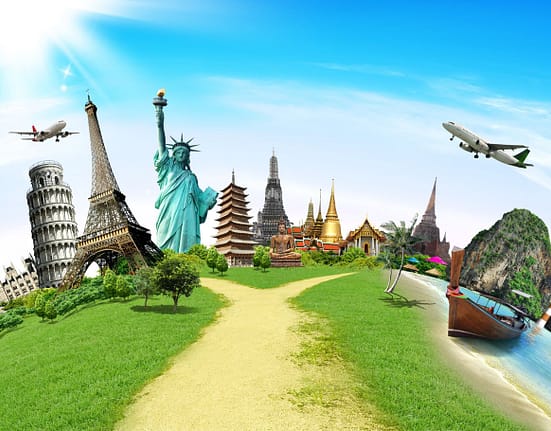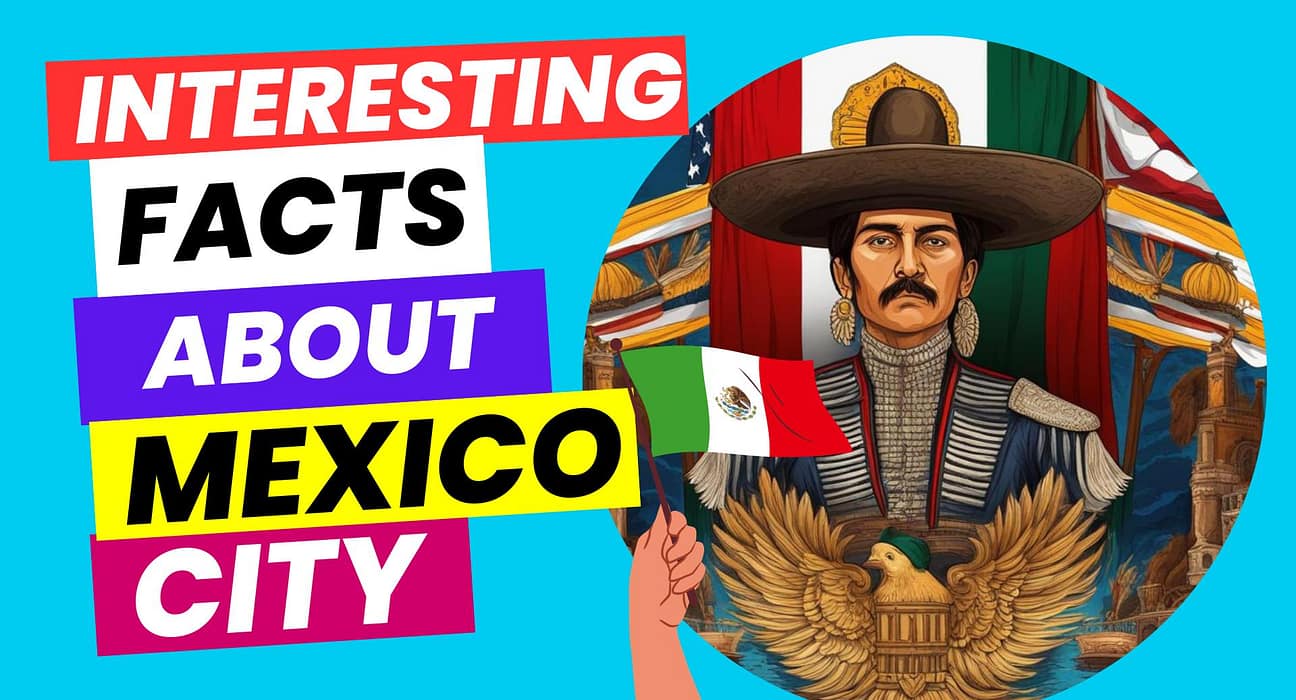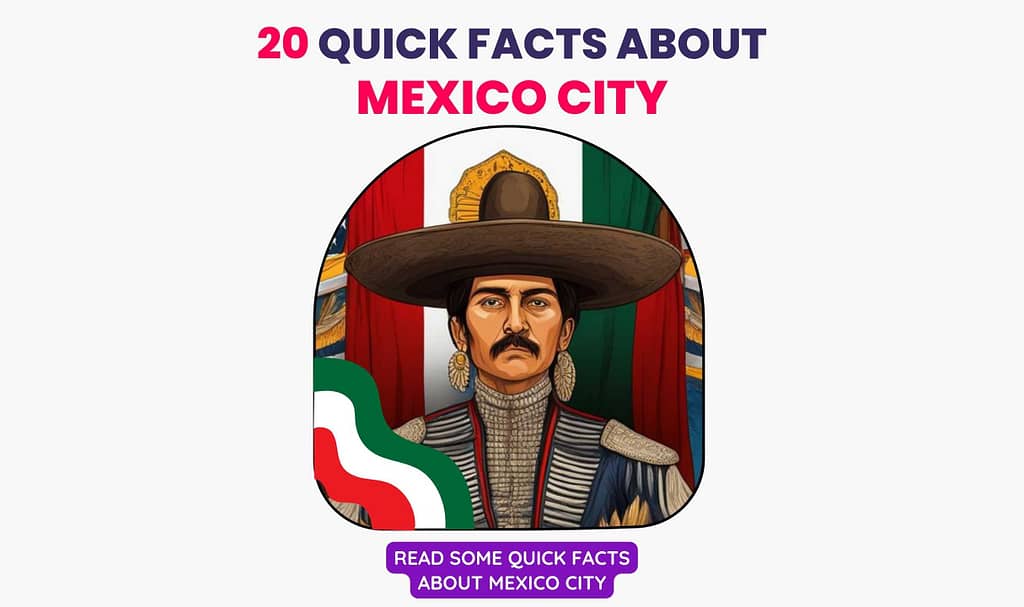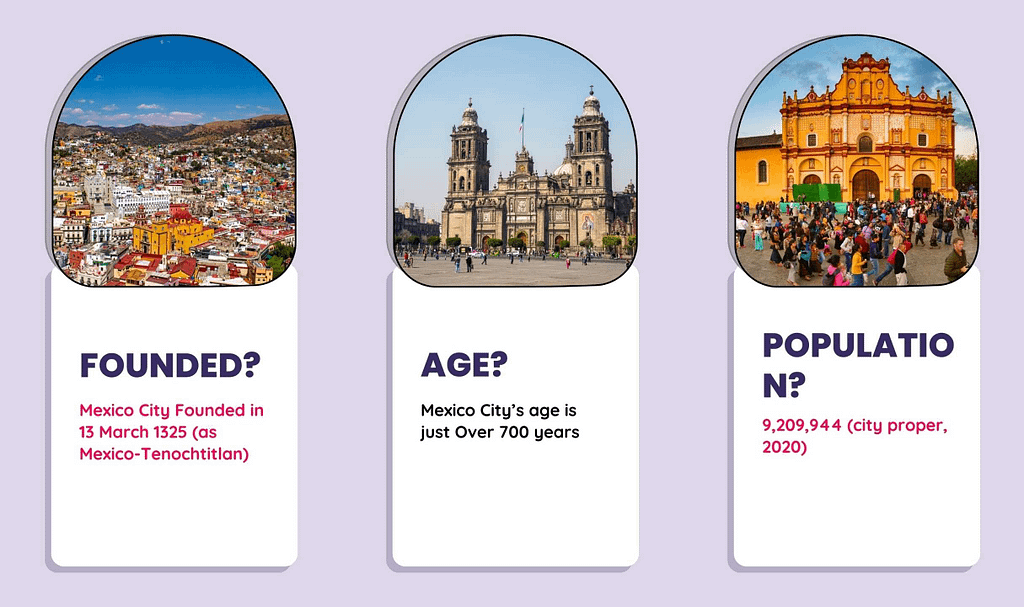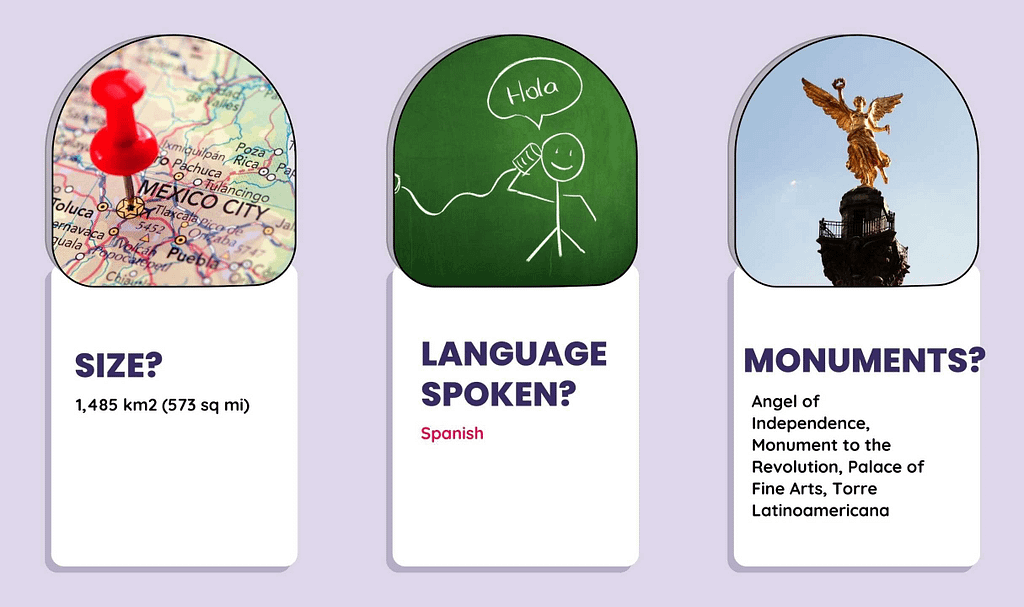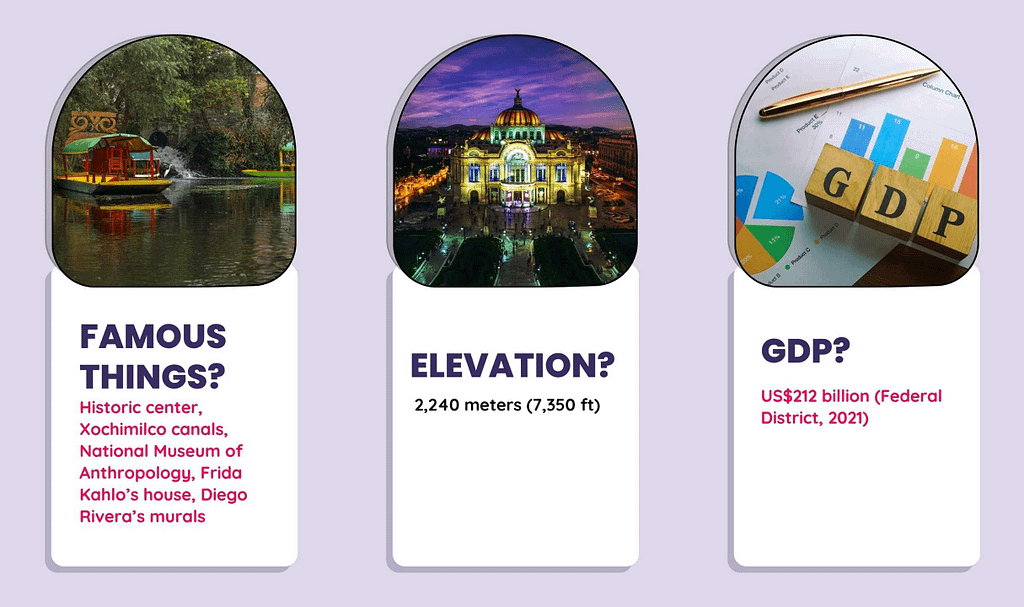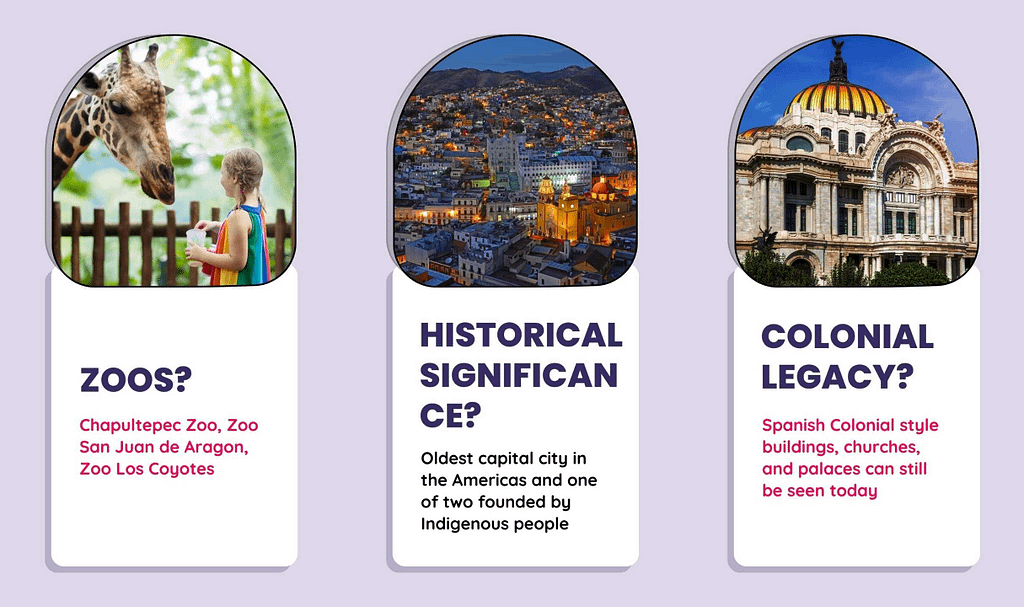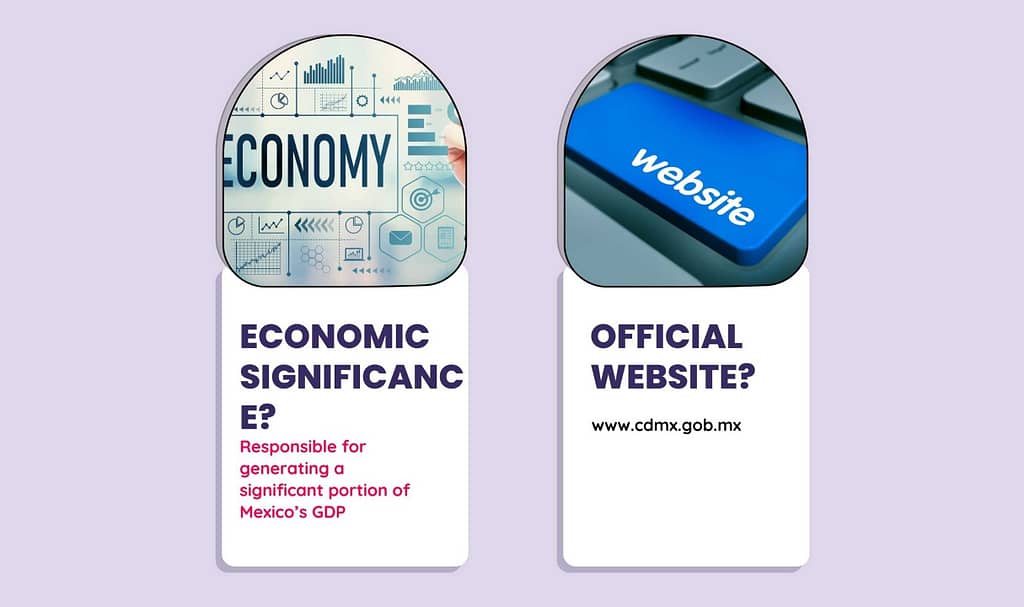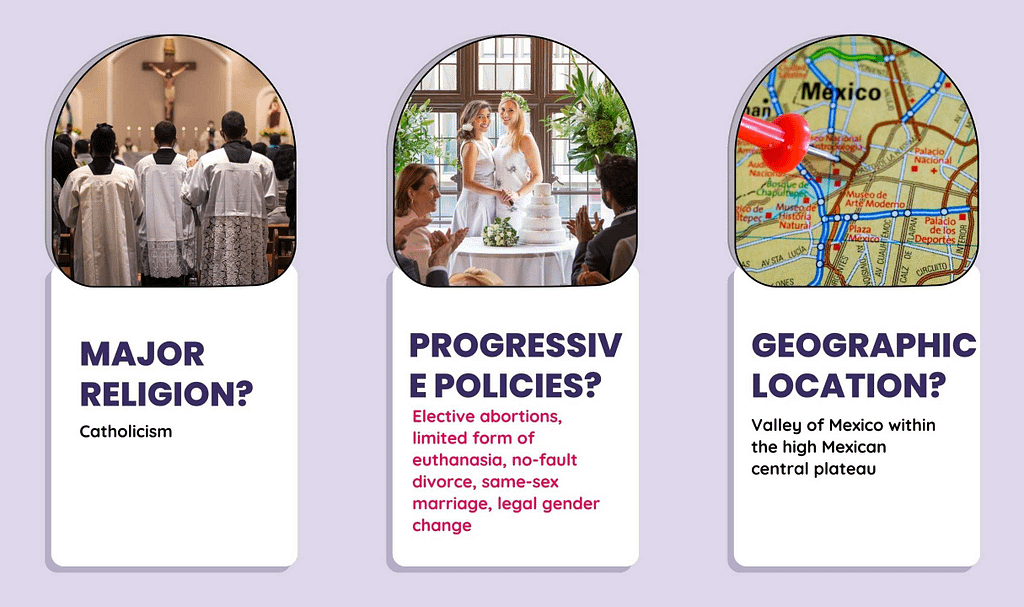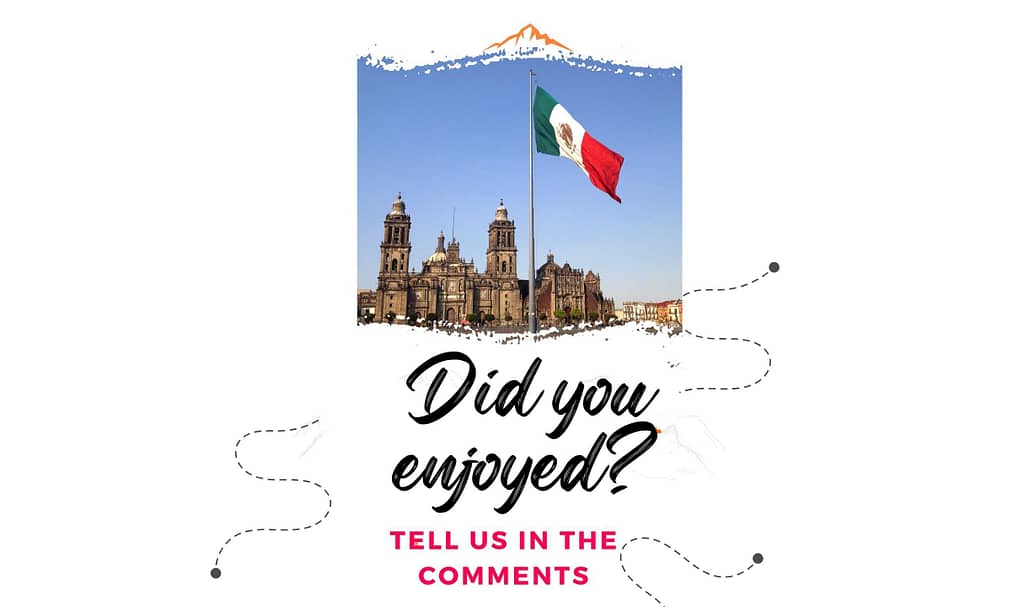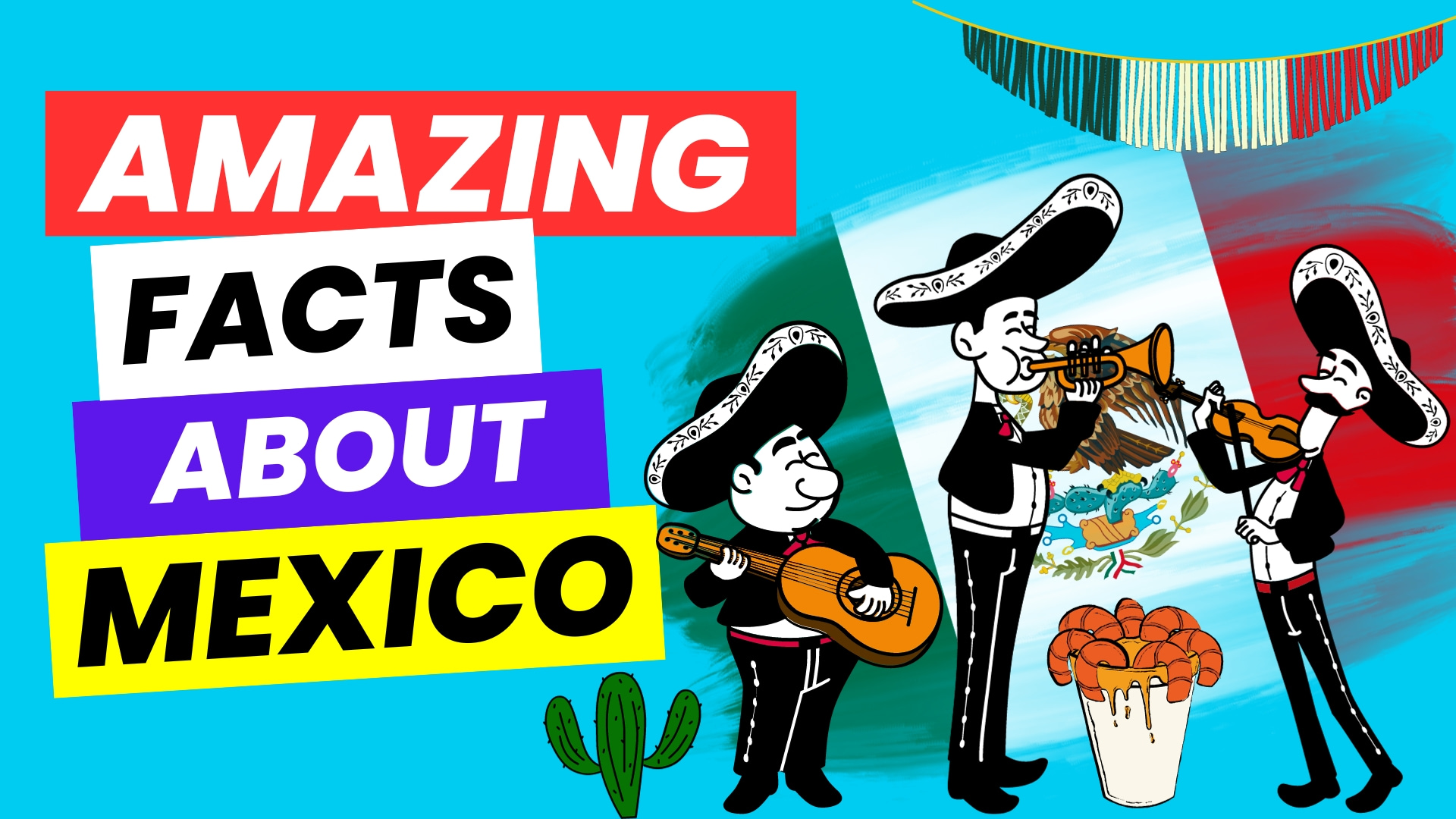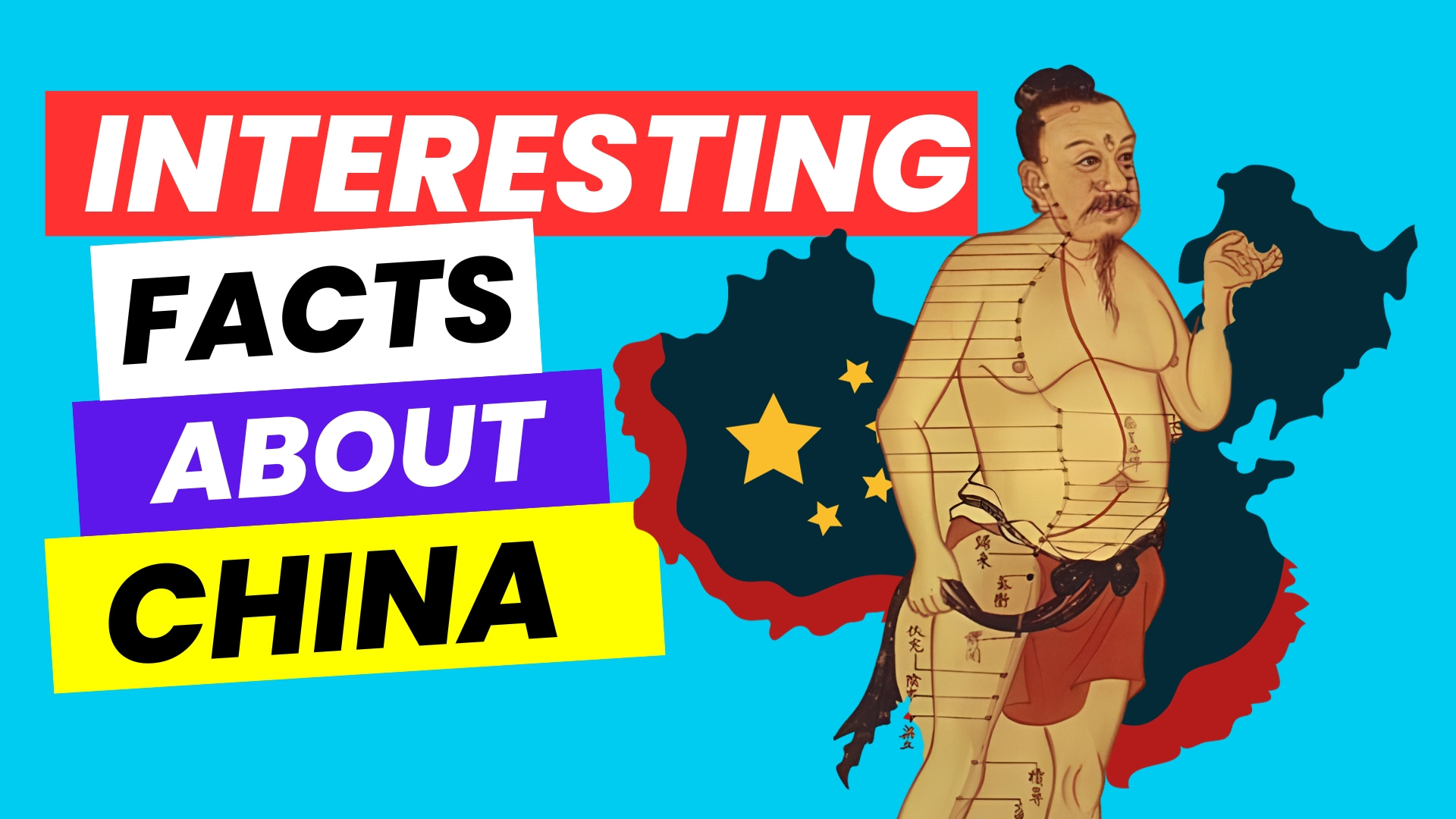Last updated on May 21st, 2024 at 03:26 pm
Are you here to learn some interesting facts about Mexico City? Then welcome to our comprehensive facts guide.
In this blog post, you will find reliable and interesting Mexico City facts.
I have spent more than a week on this blog, which includes research from reliable sources like Britannica, Wikipedia, Statista and more…, creating infographics, adding some relevant AI images and pictures. And of course, writing long form content in such a way that is helpful to you.
Here is my story..
I am a big fan of the country Mexico, their football and wanted to explore the famous Mexico City. Moreover, I love the Mexican culture, their cuisines, people and how they celebrate life, there is much more to explore.
Frankly, I haven’t visited Mexico City yet (little curious about the safety as a tourist), but this research is my first step to get prepared and I’ll visit Mexico City very soon.
Preparation of this blog post..
I started to include all the facts in one blog post. Then the word count reached more than what one can read in one sitting. Then, I decided to split into each category and organize the facts into fun & interesting facts, Incredible, unique facts, etc.
The list does not end here. I’ve also created categories like fun facts, Weird facts, Historical and cultural, geographical facts and similar categories.
Infographics: 30 Interesting Mexico City Facts
Here is a visual presentation of interesting Mexico City facts in infographics.
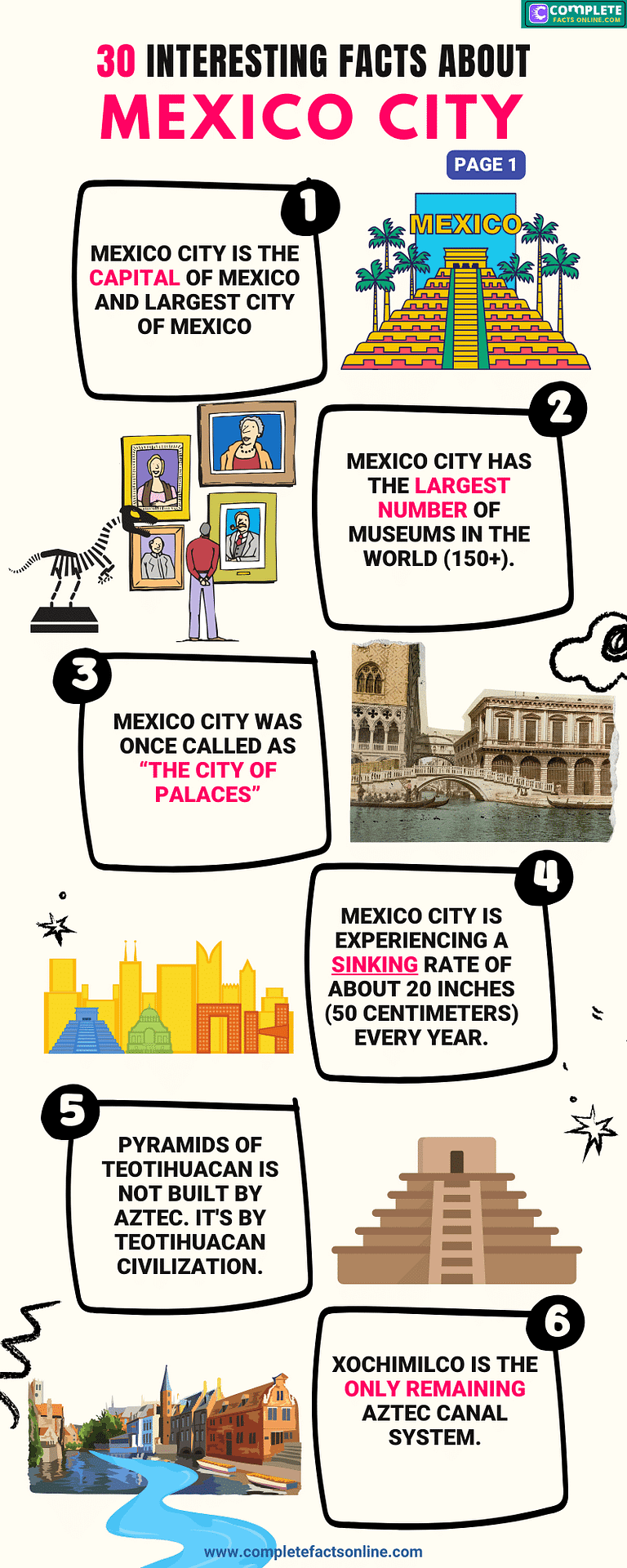
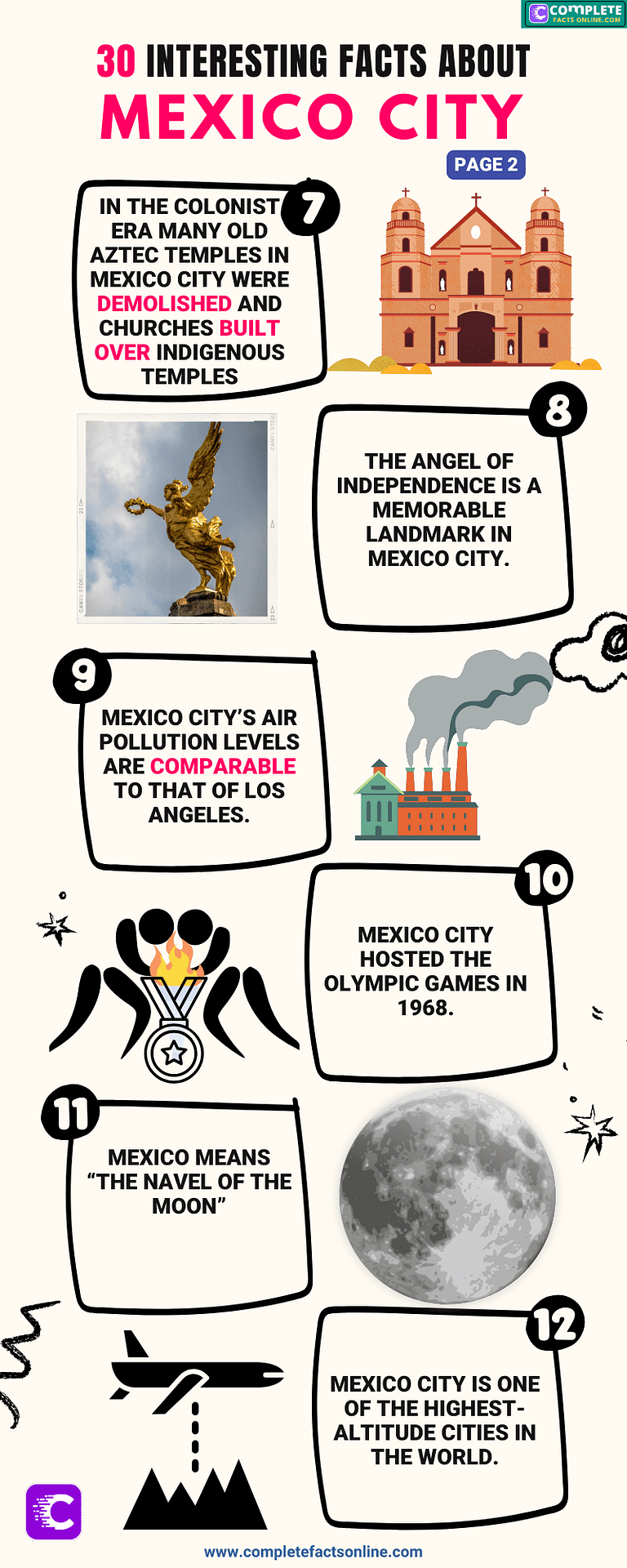
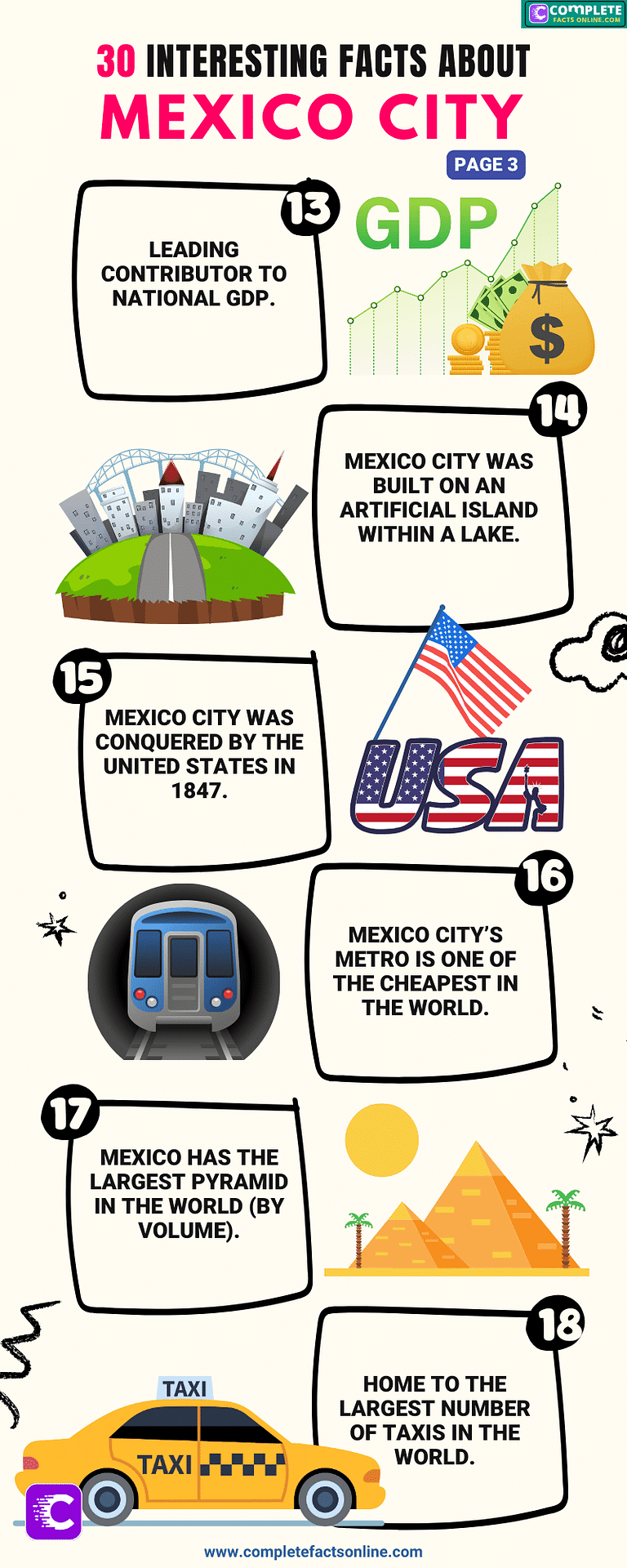
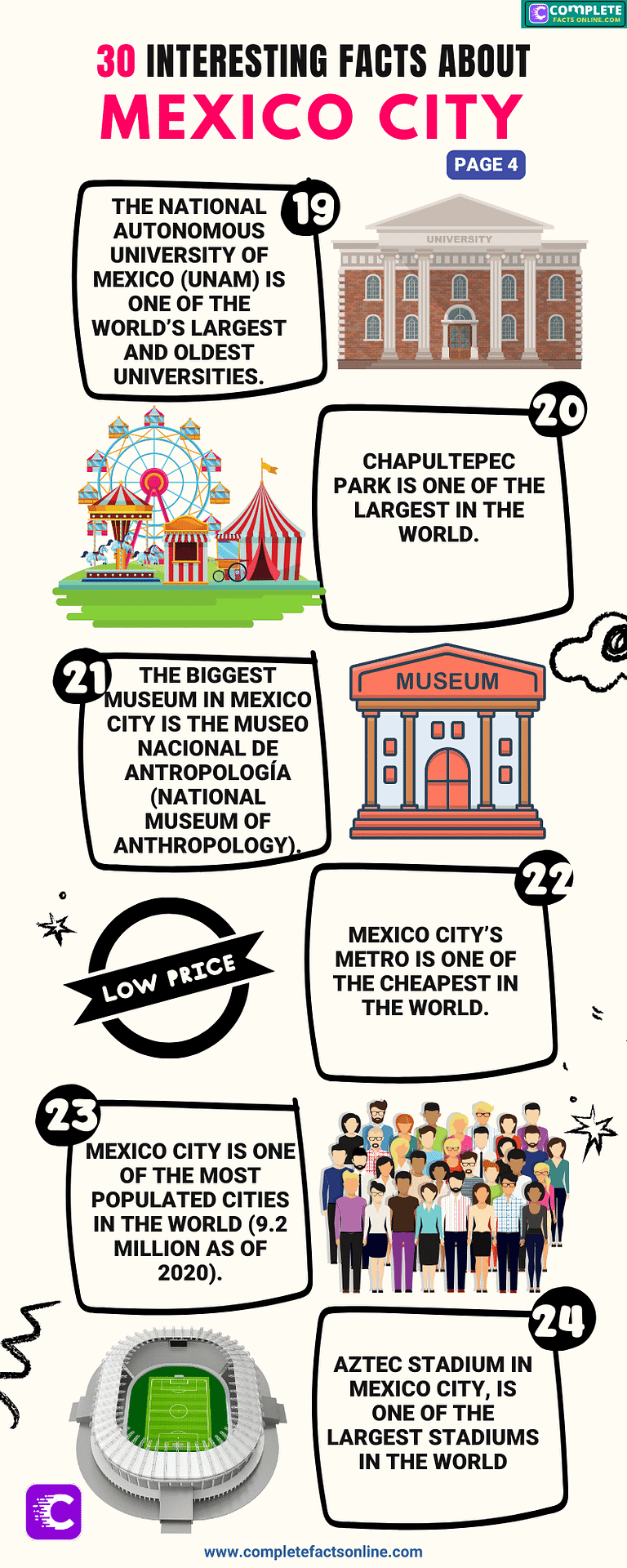
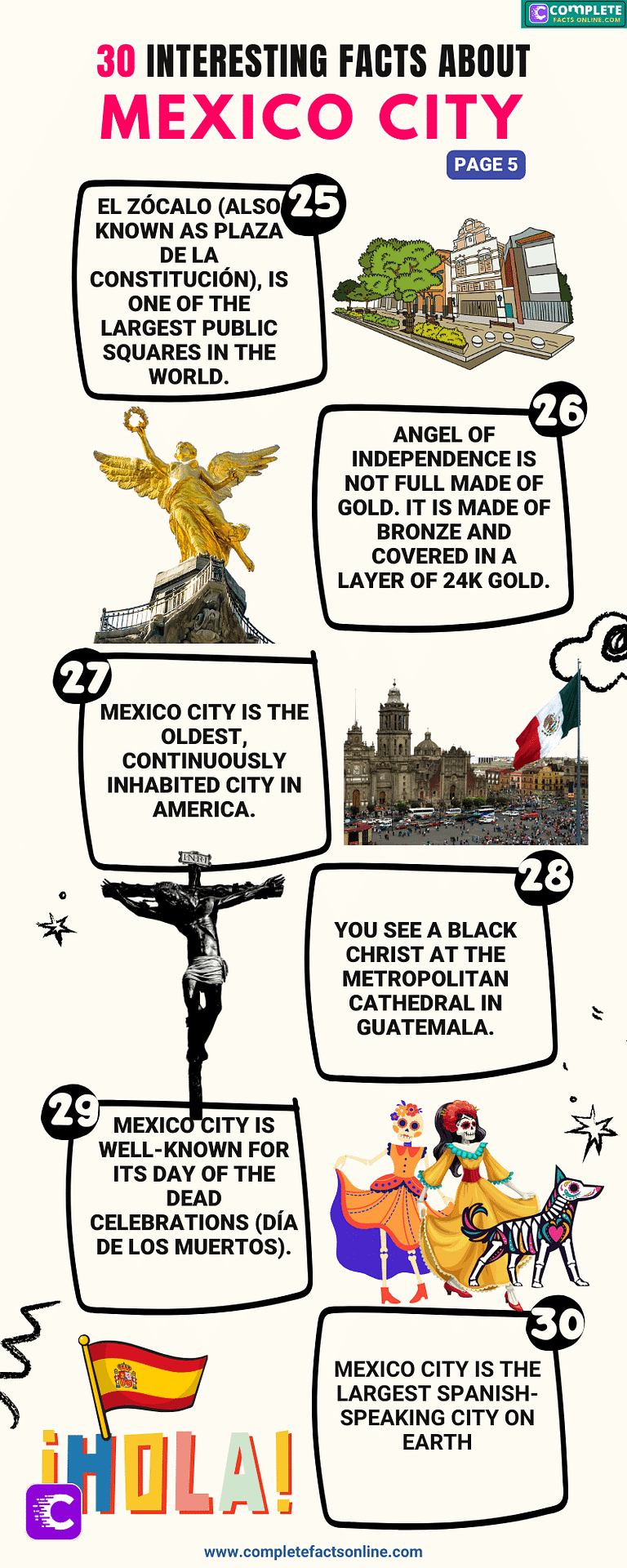
Fast Facts about Mexico City in Infographics
Did you enjoy this infographics? or need to improve? Write in the comments!
Interesting Facts about Mexico City
Here are some interesting Mexico City facts for you.
1. Mexico City is the capital of Mexico and largest city of Mexico
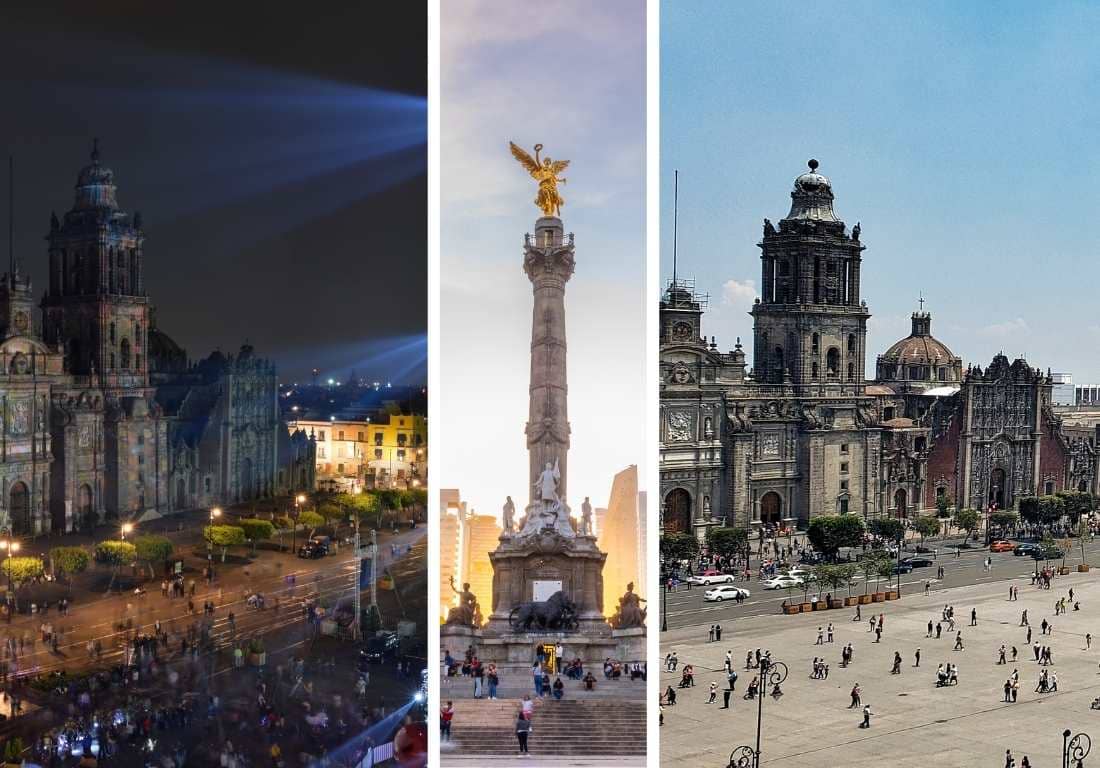
Mexico City, (also known as Ciudad de México) is not only the capital city but the largest city of Mexico. This is a prime cultural and financial center in the Valley of Mexico.
2. Mexico City has the largest number of museums in the world
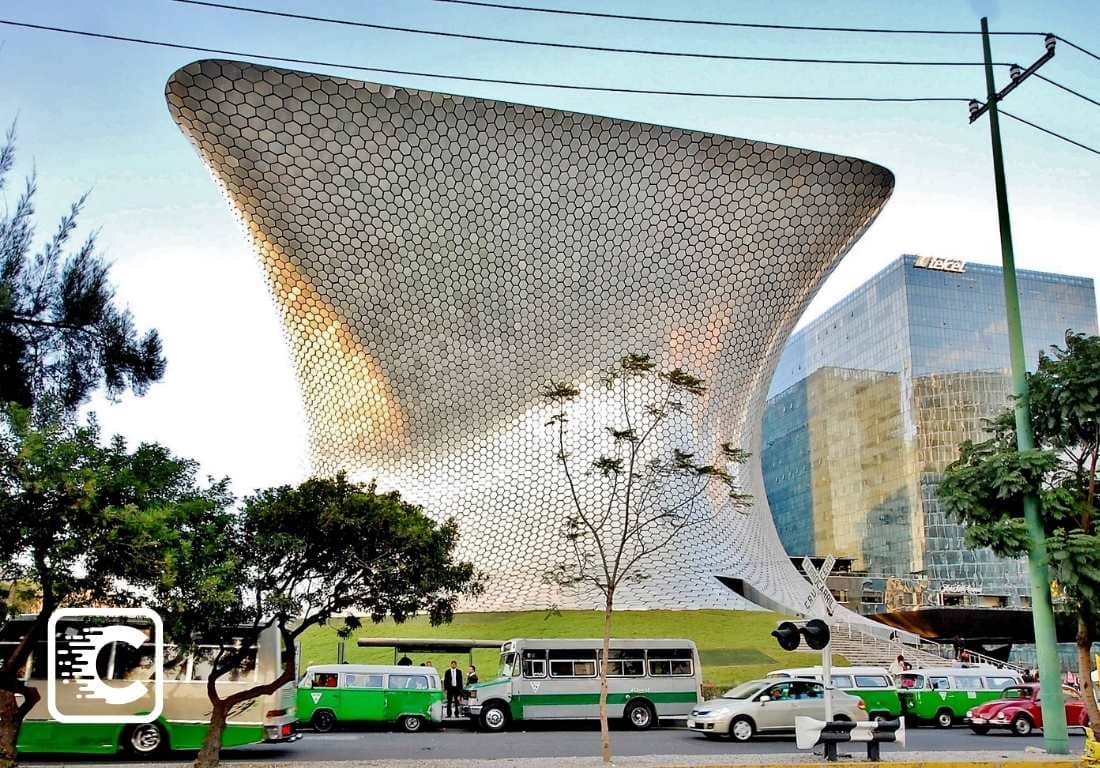
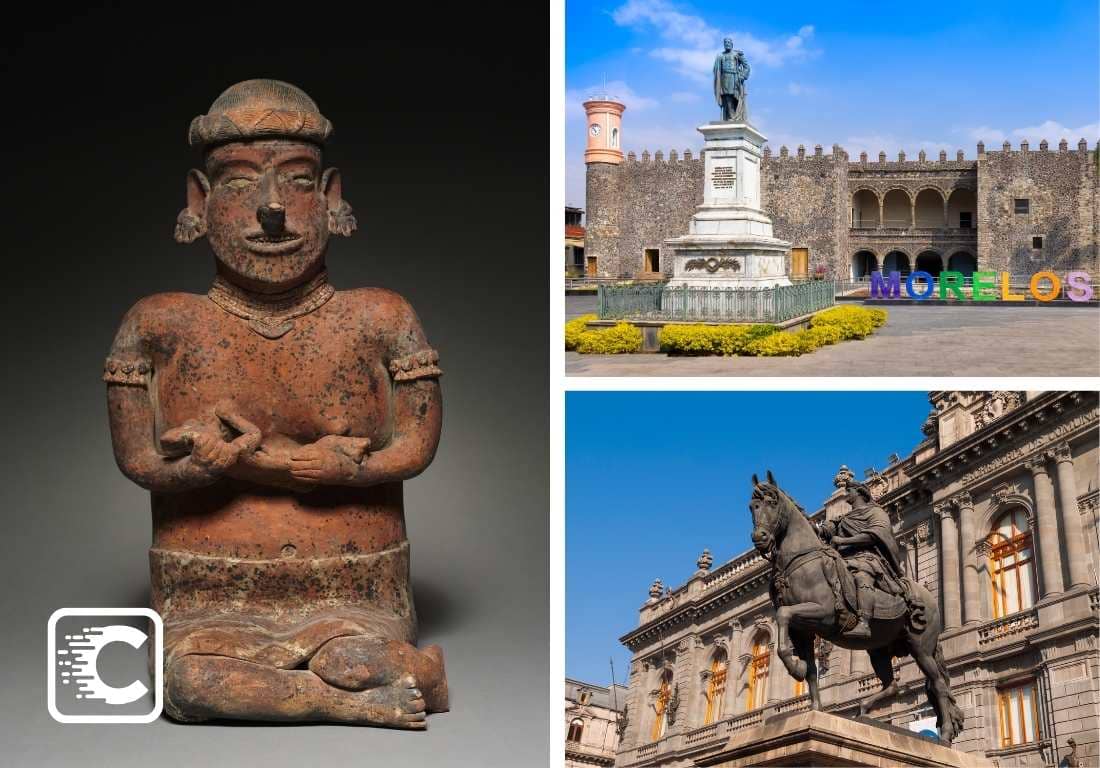
Mexico City is famous for the largest number of museums in the world. It has over 150 museums. These museums cover a wide range of subjects including art, history and culture.
3. Mexico City was Once called as “The City of Palaces”
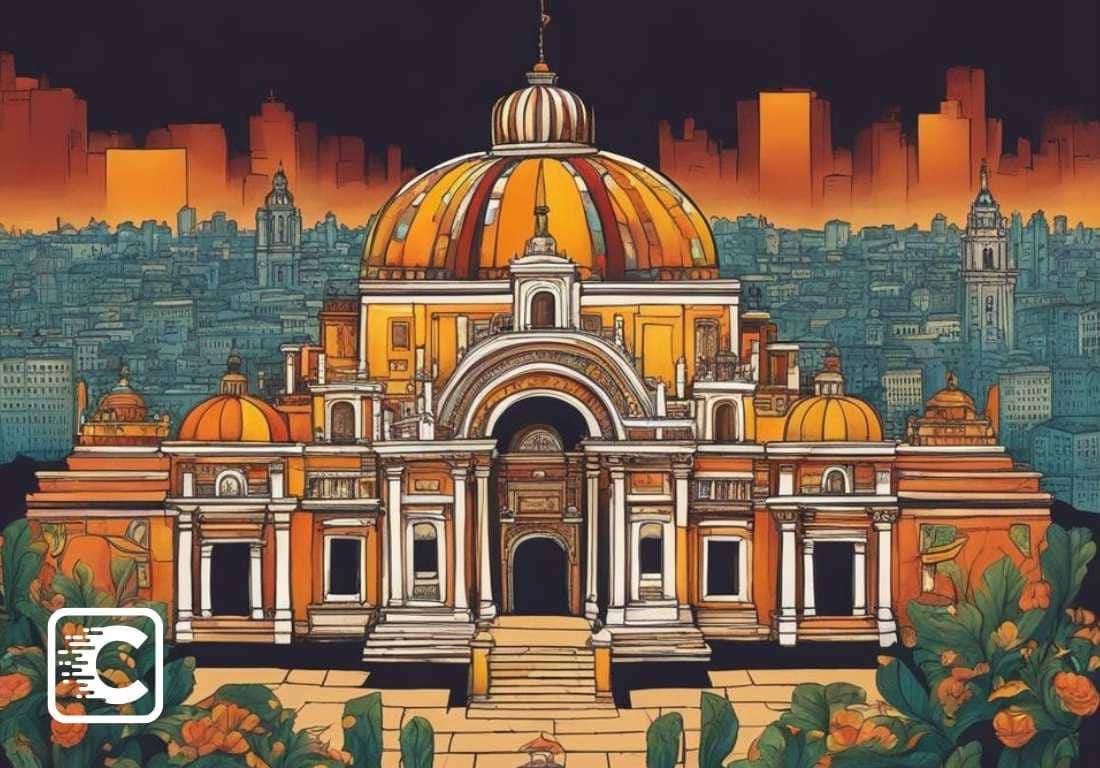
Long ago, Mexico City was once called “The City of Palaces.” It is a nickname attributed to Baron Alexander von Humboldt.
Truly this nickname underscores the city’s historical significance (in the form) of a cultural and financial center. Plus the city is famed for its rich architectural and historical landmarks.
4. Mexico City is sinking every year

Mexico City is experiencing a sinking rate of about 20 inches (50 centimeters) every year. It is generally due to the over-extraction of groundwater.
Over the years it has resulted in significant subsidence issues. This includes challenges with runoff and wastewater management. These lead to increased flooding especially even during the summer months.
5. Xochimilco is the only remaining Aztec Canal System.
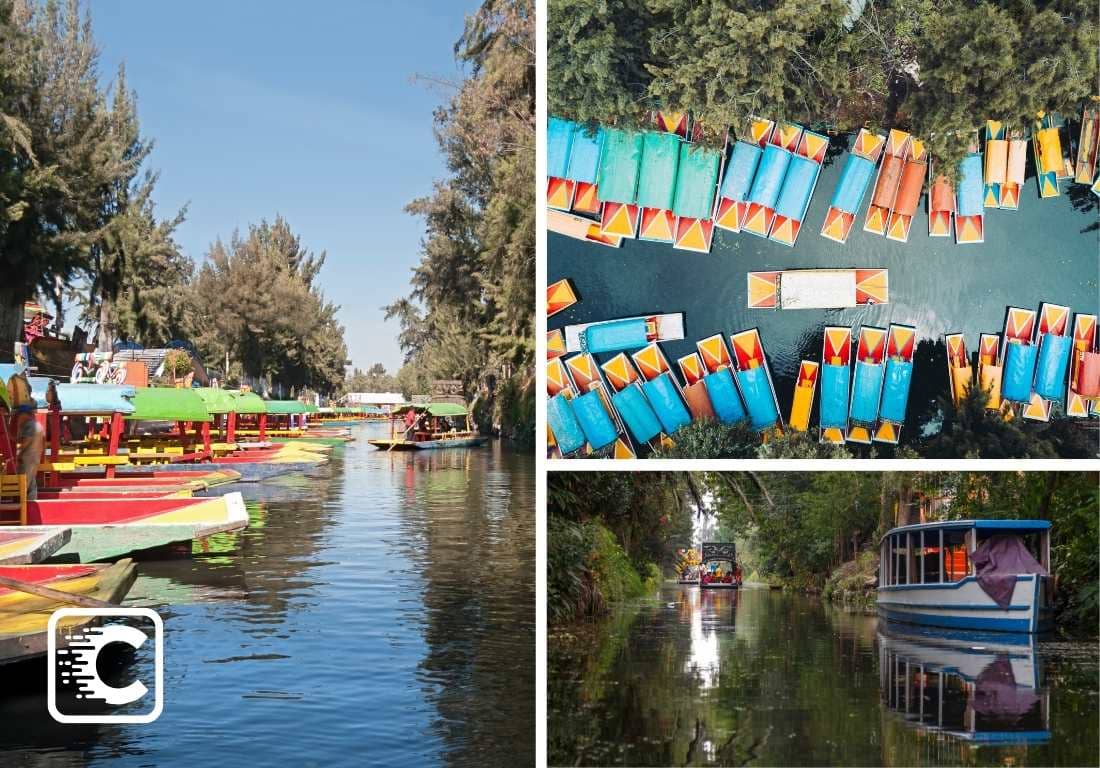
Xochimilco is home to the only leftover Aztec canal system. Thank God! It is a UNESCO World Heritage Site and a principal cultural and historical landmark in Mexico City.
The ancient system of canals in Xochimilco delivers an exceptional sight into the Aztec civilization’s innovative and fabulous water management system models. This system of canals was deployed for transportation, trade and agriculture. It was an important part of the city’s infrastructure.
Besides, the agricultural customs make it a valuable cultural and historical asset.
6. Churches Built Over Indigenous Temples
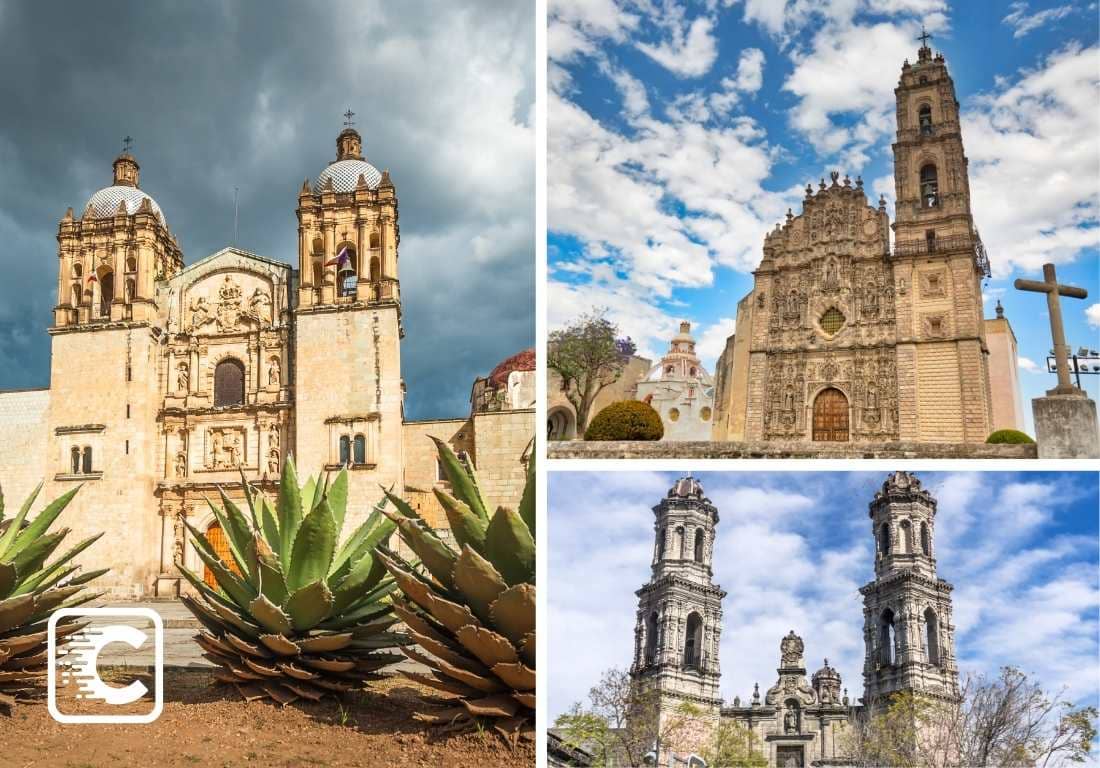
In the colonist era many old Aztec temples in Mexico City were demolished and swapped by Catholic churches.
This architectural transformation reflects the cultural and religious shifts fetched by Spanish colonization in the region.
7. The Angel of Independence represents the city
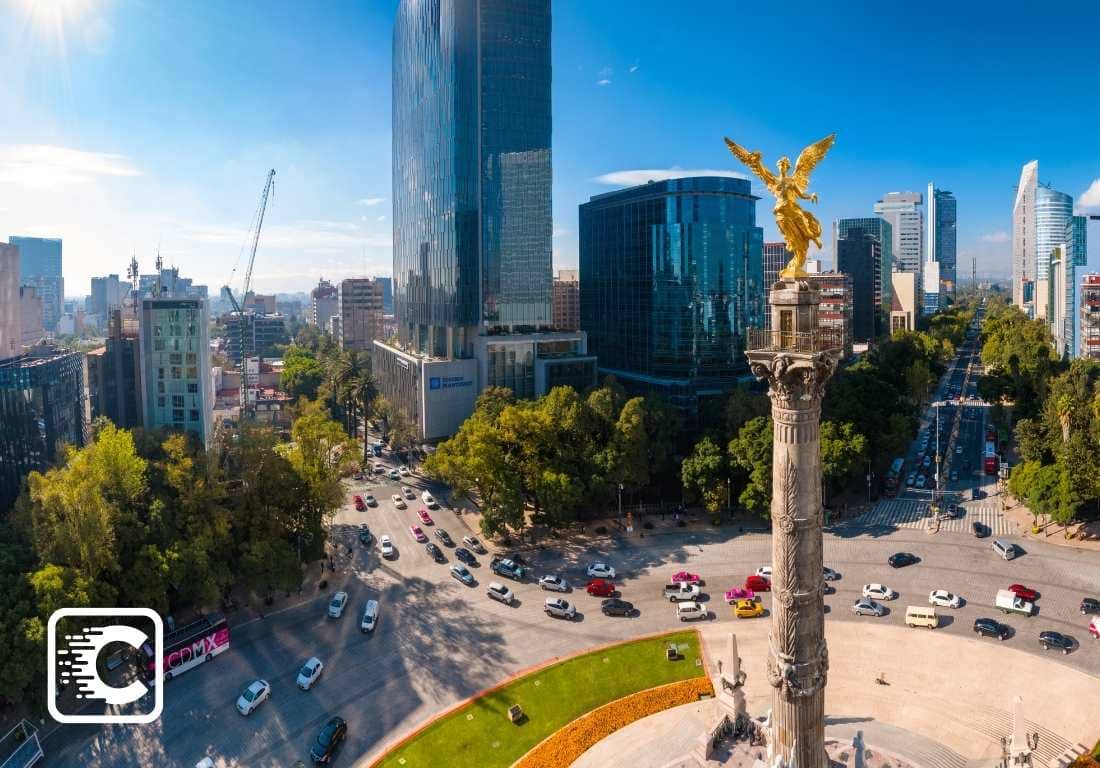
The Angel of Independence is a memorable landmark in Mexico City. Unquestionably, it pictures the city’s resilience and its quest for independence.
This iconic memorial refers to Mexico’s struggle for freedom, and apart from that, it is an influential emblem of national identity and pride.
8. Mexico City’s Air Pollution is comparable to that of Los Angeles

Mexico City’s air pollution levels are comparable to that of Los Angeles. It’s been a major environmental concern.
This comparison (of air pollution) underlines the sense of addressing air quality issues in Mexico City to raise public health and environmental soundness.
9. Mexico City hosted the Olympic Games in 1968
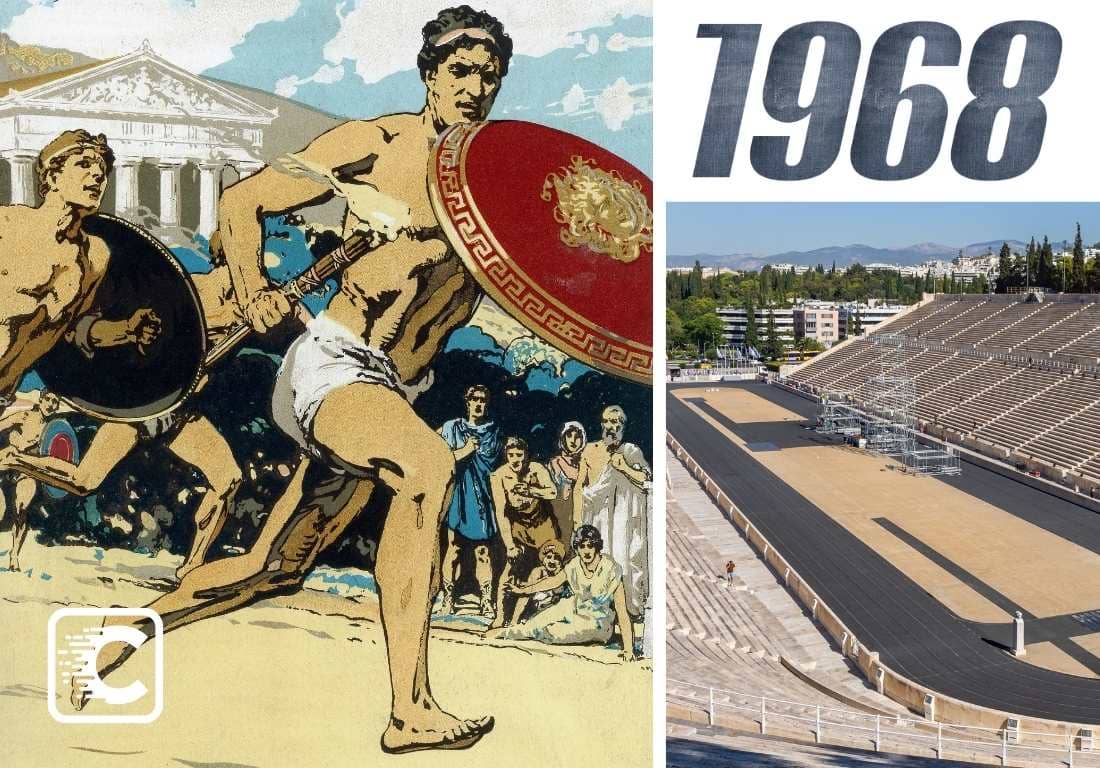
Mexico City hosted the Olympic Games in 1968. This event is a significant moment in the city’s history. Furthermore, this exhibits its ability to set up and host any major international events. This global event brought world attention to Mexico City and left an immortal legacy in the city’s sports-infrastructure and cultural heritage.
10. Mexico Means “the Navel of the Moon”
The name “Mexico” originated from the Nahuatl wording “Mēxihco” or “Mēxihcah”. It is deemed to mean “the navel of the moon.” This etymological origin mirrors not just the rich cultural and linguistic legacy of the region but its indigenous roots.
11. One of the highest-altitude cities in the world
Mexico City is one of the highest-altitude cities in the world. It is situated at a peak of 2,240 meters (7,350 feet) over sea level. This high altitude has a substantial effect on the city’s climate, geography and the well-being of its inhabitants.
12. Leading contributor to National GDP
In 2021, Mexico City contributed roughly 2.94 trillion Mexican pesos to the national GDP of Mexico. This is 17.28 percentage of the total GDP and ranks top of the contributor’s lists.


Source: Statista
Incredible Mexico City Facts
Here are some incredible Mexico city facts for you.
13. Mexico City was built on an artificial island within a lake

In the 14th century, Mexico City was originally built on an island within Lake Texcoco by the Aztecs. In 1325 or 1327, the city, named Mexico-Tenochtitlan founded by the Mexica people.
The old Mexica city, now comprehended as Tenochtitlan, was built on an island in the center of the inland lake system of the Valley of Mexico. It was shared with a smaller city-state called Tlatelolco.
14. Mexico City Was Conquered by the United States in 1847
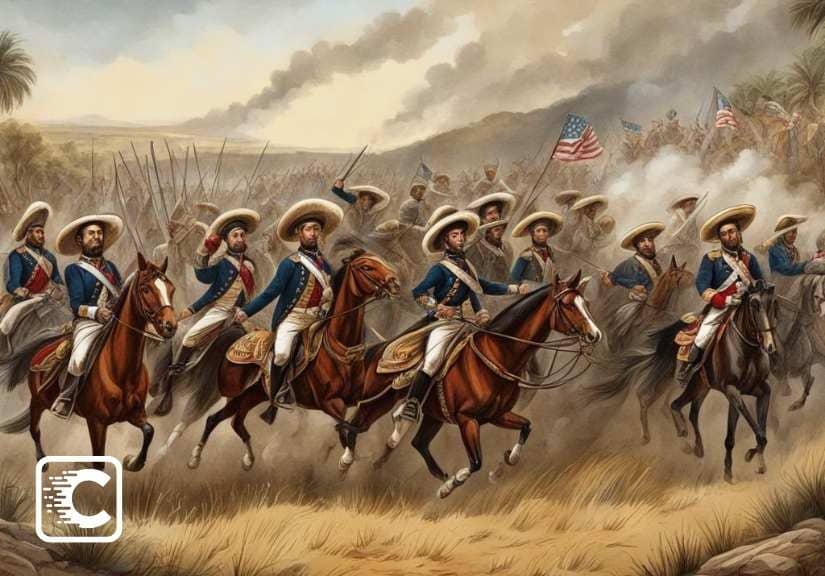
During the U.S.-Mexican War in 1847, the American invasion of Mexico City resulted in a chain of engagements. It concluded with the fall of Mexico City. The U.S. Army, under Winfield Scott, acquired a major success.
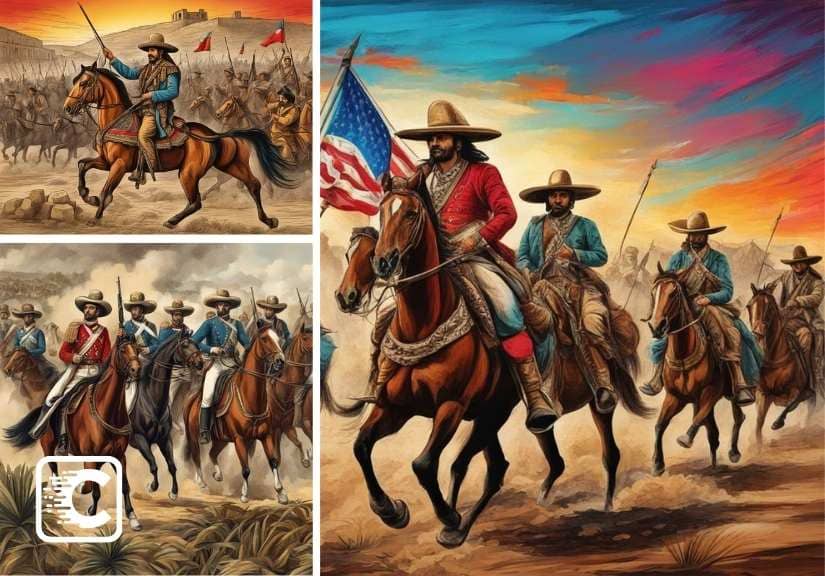
The American invasion into the Federal District was first opposed during the Battle of Churubusco on 8 August. Then, It ultimately resulted in the seizure of Mexico City and Veracruz by the U.S. Army’s divisions.
15. Mexico City’s metro is one of the cheapest in the world
Mexico City’s metro system is well-known for being one of the most inexpensive in the world. The low cost of the metro has made it an essential mode of transportation for millions of residents. Not only that contributes considerably to the city’s mobility and accessibility.
16. Mexico has the Largest Pyramid in the World (By Volume)
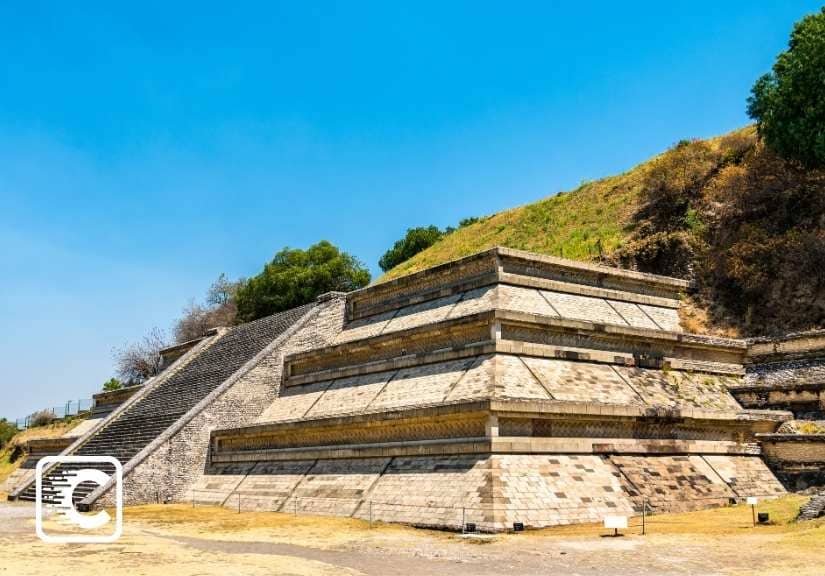
Yes, the largest pyramid in the world by volume is the Great Pyramid of Cholula and it’s located near Puebla, Mexico. It is a gigantic ancient structure that forms part of the Cholula archaeological zone.
“Largest” Mexico City Facts
Here are few “largest” category facts
17. Home to the largest number of taxis in the world
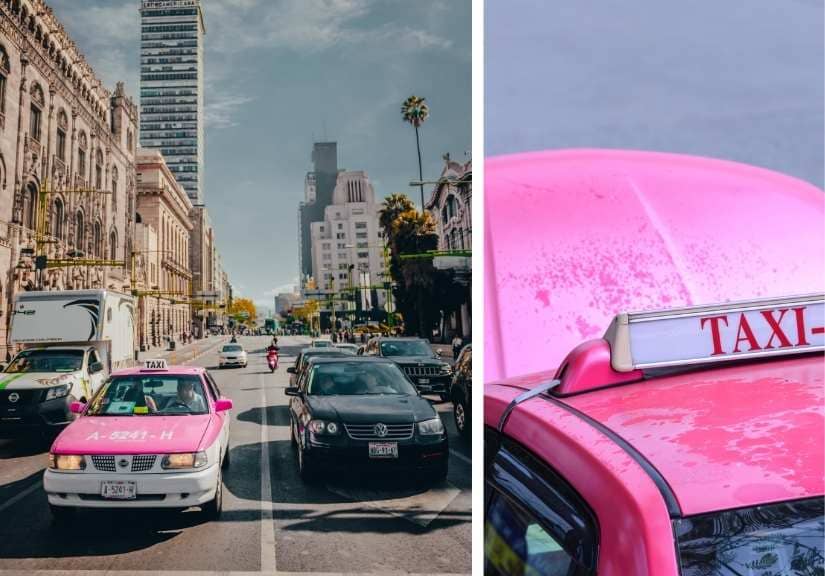
Mexico City definitely has one of the largest taxi fleets in the world. The sheer number of taxis in the city makes them a universal mode of transportation. It supplies essential mobility for residents and visitors alike.
18. One of the World’s Largest and Oldest Universities
The National Autonomous University of Mexico (UNAM) is one of the world’s largest and oldest universities. It was founded in 1551. Furthermore, it has a significant historical and academic legacy. UNAM is celebrated for its extensive campus, rich cultural heritage and contributions to research and education.
19. Chapultepec Park is one of the largest in the world
Chapultepec Park in Mexico City is one of the largest city parks in the world. Its expansive size and rich historical significance make it a core feature of the city’s landscape and a popular destination for locals and tourists.
20. The Largest Museum in Mexico City
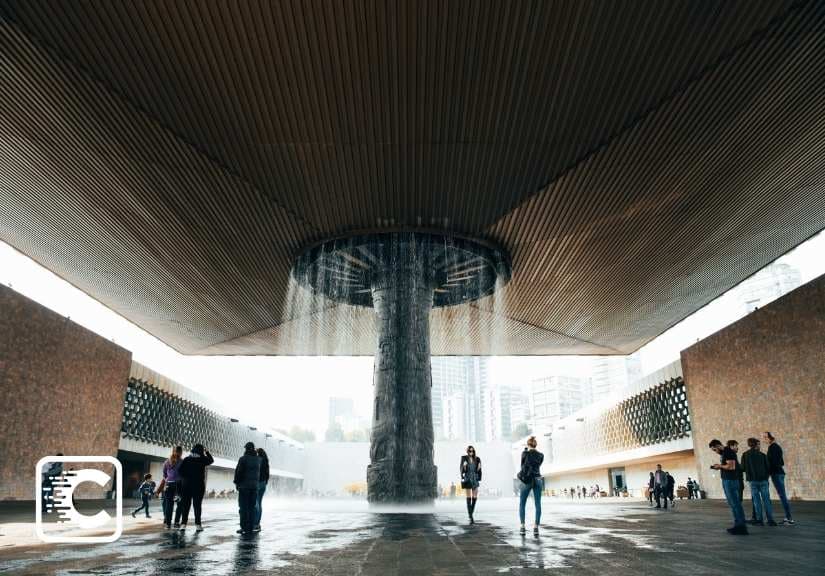
The biggest museum in Mexico City is the Museo Nacional de Antropología (National Museum of Anthropology). This museum houses the most crucial compilation of pre-Columbian artifacts, comprising the Aztec Calendar Stone and the statue of Xochipilli.
21. One of the Most Populated Cities in the World
Mexico City ranks as one of the most populous cities globally. According to Statista, the total population in Mexico City is 9.2 million as of 2020. Its population density reflects its status as a major economic and cultural hub in Latin America.


Source: Statista
22. The Aztec Stadium is one of the largest stadiums in the world
Located in the City of Mexico, the Azteca Stadium is one of the largest stadiums in the world. It has splendid capacity and a storied history. Additionally, it is well known as a venue for various sporting and cultural events.
In terms of seating capacity, the Azteca Stadium in Mexico City is one of the largest football stadiums in the world. It can seat 91,653 fans, making it the biggest stadium in Latin America and positioning it amongst the top globally.
23. The Subway is the largest in Latin America
The Mexico City Metro is the largest rapid transit system in Latin America. Consisting of 12 lines and 195 stations, it is one of the most extensive metro systems in the world. Daily, the metro system serves millions of passengers. Moreover, it plays a vital role in the city’s transportation network.
24. El Zocalo: One of the largest public squares in the world
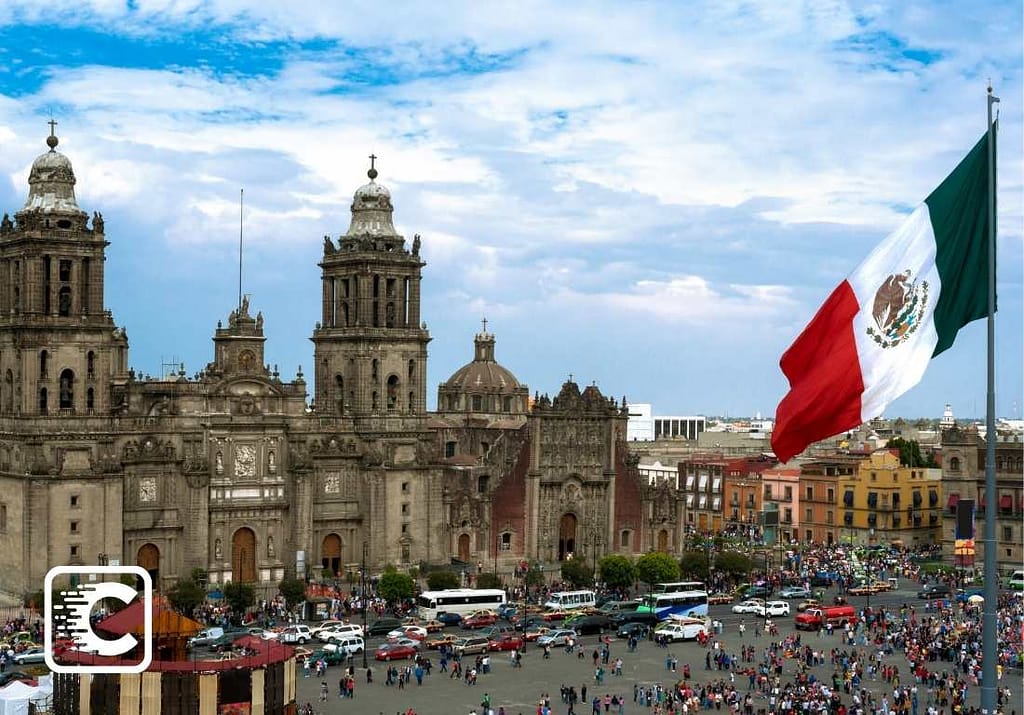
Yes, El Zócalo (also known as Plaza de la Constitución), is one of the largest public squares in the world. It’s located in the historic center of Mexico City; and is famous for its historical and cultural significance, as well as its immense size.
Unique Facts about Mexico City
25. Mexico City’s Angel of Independence is not full gold

In a broad sense, we can say it is made of gold. But, the Angel of Independence in Mexico City is not made of gold. This belief is incorrect. It is made of bronze and covered in a layer of 24k gold.
This iconic victory column monument located on Paseo de la Reforma, memorializes Mexico’s struggle for independence.
26. Mexico City is home to architecture of 3 kinds
Mexico City is indeed home to architecture of three main kinds: pre-Columbian, colonial and modern. The city’s architecture reflects its rich history and cultural diversity.
It not only features ancient Mesoamerican structures, but Spanish colonial buildings and contemporary architectural marvels. Each of these architectural styles contributes to the unique and vibrant character of Mexico City.
27. Mexico City is the oldest, continuously inhabited city in America
Mexico City is an old city in the Americas. It has been constantly inhabited for a long time. The Mexica (Aztecs) built it around 1325 on islands in Lake Texcoco. They called it Tenochtitlan.
After the Spanish conquest, the city was redesigned and rebuilt. Finally, it became the capital of New Spain. Mexico City’s rich history makes it one of the oldest urban centers in the Americas.
28. You see a Black Christ at the Metropolitan Cathedral
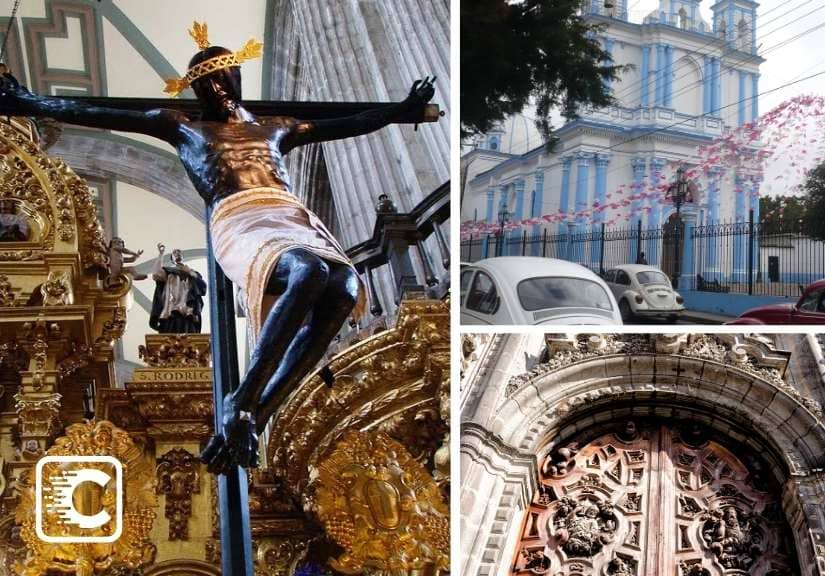
The Black Christ at the Metropolitan Cathedral in Guatemala is an influential mark. It is associated with the worship of a crucifix in Esquipulas. This town is near the borders of Honduras and El Salvador.
The image was sculpted in 1595. Then it gradually turned black over time. Interestingly, it gained a reputation for its miraculous powers. As a result, a sanctuary was established for this and became the most visited site in the region.
Millions of people from the city and outside, come to see the Black Christ of Esquipulas. It is a vital aspect of Central American religious practice and identity. The Historical and academic documentation of this validates its authority and widespread impact.
29. México City Has the only Monarchic Castle in the American Continent
Mexico City has the only royal castle on the American continent. It’s called Chapultepec Castle. It’s an old place with many past roles. Emperor Maximilian I once lived there.
Empress Carlota did too, back in their day. Now, it’s the National Museum of History. You can see all of Mexico City from there. The views are really wide and clear.
30. The city is known for its vibrant Day of the Dead celebrations
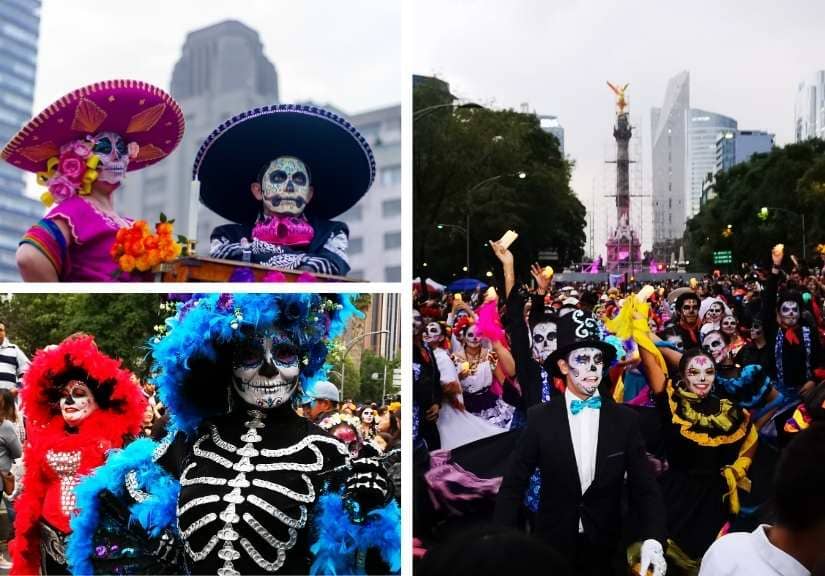
Mexico City is well-known for its Day of the Dead celebrations (Día de los Muertos). It is held from October 31 to November 2. The city is filled with colors, altars, parades and events to remember the deceased loved ones. It’s a center for the special Day of the Dead traditions.
The festive atmosphere and rich traditions make Mexico City an excellent hub for the celebration of the Day of the Dead. It allows for experiencing the unique and meaningful celebrations of Día de los Muertos.
31. The city hosts the International Cervantino Festival
Yes, that’s correct. Mexico City hosts the International Cervantino Festival, named after “Don Quixote” author Cervantes.
It’s a prominent cultural event. This includes music, dance and plays. Art and writing are also part of the event. Artists from all over the world come and perform at the festival.
32. Largest Spanish-speaking city on Earth
Mexico City is the biggest city in the world where Spanish is spoken widely. Besides, it is the largest metropolitan area, with more than 21.2 million residents (more than New York or Los Angeles).
The city’s population has increased by over 20 million in just over 110 years, which is astounding.
33. In Mexico City, an active volcano is located right next
Yes, that’s right! It’s Popocatépet, an active volcano located approximately 70 km southeast of Mexico City in the states of Puebla and Morelos. In fact it is the second-highest peak in Mexico with an elevation of 5,426 meters (17,802 feet) above sea level.
Popocatépetl has been active in recent years (January 9, 2020), with periodic eruptions and emissions of gas, ash, and steam. This volcano is thoroughly monitored by the National Center for Disaster Prevention (CENAPRED) to appraise volcanic activity. This is mainly to ensure the safety of nearby residents.
34. Aztec Does not Construct Pyramids of Teotihuacan
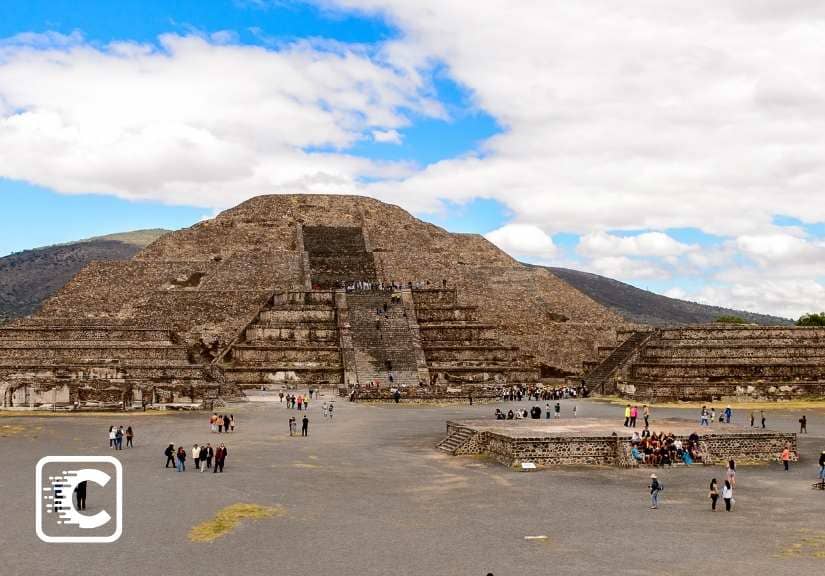
The Pyramids of Teotihuacan (including the Pyramid of the Sun and the Pyramid of the Moon) are not of Aztec origin. These were constructed by the Teotihuacan civilization, which was only discovered by the Aztecs in the 14th century. Only discovered it! I wrongly believe this was built by Aztec. Maybe you too!
The Teotihuacan civilization flourished in the middle the 1st and 7th centuries CE. Whereas, the Aztec civilization emerged centuries thereafter in the 14th century.
Archaeological evidence (including artifacts and murals) found at Teotihuacan, points out that the city was a major cultural and religious center prior to the emergence of the Aztec Empire.
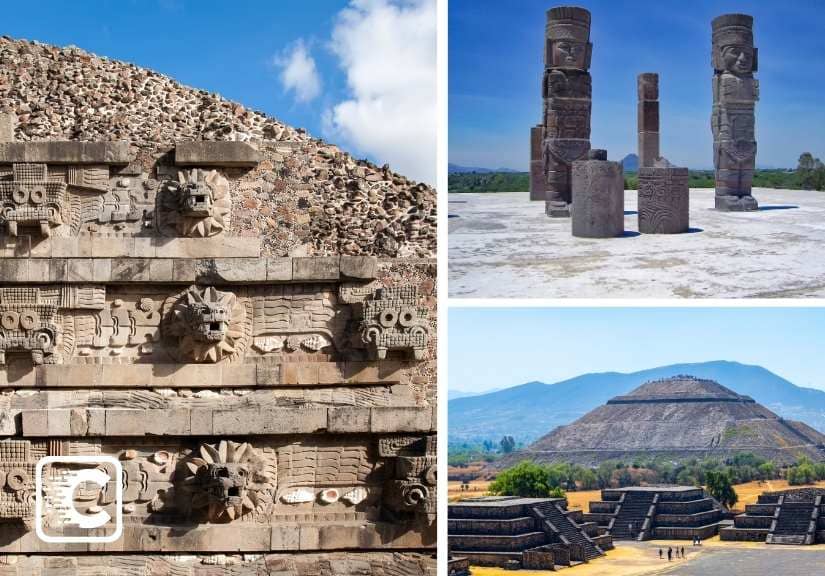
In fact, the similarities in architecture and religious symbolism within Teotihuacan and later Mesoamerican civilizations hint that the site had a considerable sway on Aztec culture and religious practices.
One lesser-known fact about Teotihuacan is that the original name of the city is anonymous. This is primarily due to the fact that civilization did not leave trustworthy written records. It led to continuing scholarly debate about its true name and the identity of its rulers.
Quick Facts about Mexico City
| Quick Facts | Information |
|---|---|
| Founded | 13 March 1325 (as Mexico-Tenochtitlan) |
| Age | Over 700 years |
| Population | 9,209,944 (city proper, 2020) |
| Size | 1,485 km2 (573 sq mi) |
| Language spoken | Spanish |
| Major parks | Chapultepec Park, Alameda Central, Parque México, Parque España, Parque Hundido, Viveros de Coyoacán, Bosque de Tlalpan, Xochimilco Ecological Park, Desierto de los Leones National Park |
| Monuments | Angel of Independence, Monument to the Revolution, Palace of Fine Arts, Torre Latinoamericana |
| Famous things | Historic center, Xochimilco canals, National Museum of Anthropology, Frida Kahlo’s house, Diego Rivera’s murals |
| Government | Mayor: Martí Batres |
| Elevation | 2,240 meters (7,350 ft) |
| GDP | US$212 billion (Federal District, 2021) |
| Time zone | UTC−06:00 (CST) |
| Nickname | CDMX, La Ciudad de los Palacios (“the City of the Palaces”) |
| Motto | La Ciudad de la Esperanza (“The City of Hope”) |
| UNESCO World Heritage Site | Historic center of Mexico City, Xochimilco and Central University City Campus of the UNAM |
| Climate | Subtropical highland climate |
| Air pollution | Drastically lowered over the years |
| Amusement parks | Six Flags México |
| Zoos | Chapultepec Zoo, Zoo San Juan de Aragon, Zoo Los Coyotes |
| Spanish colonial era | Significant influence on the city’s architecture and culture |
| Historical Significance | Oldest capital city in the Americas and one of two founded by Indigenous people |
| Colonial Legacy | Spanish Colonial style buildings, churches, and palaces can still be seen today |
| Major Religion | Catholicism |
| Progressive Policies | Elective abortions, limited form of euthanasia, no-fault divorce, same-sex marriage, legal gender change |
| Geographic Location | Valley of Mexico within the high Mexican central plateau |
| Metropolitan Area Population | 21,804,515 (2020) |
| Economic Significance | Responsible for generating a significant portion of Mexico’s GDP |
| Archaeological Significance | Oldest signs of human occupation date back to the lower Cenolithic period |
| Seismic Activity | Located in a region with frequent seismic activity |
| Environmental Challenges | Groundwater-related subsidence leading to sinking and frequent flooding problems |
| Coat of Arms | Features an eagle perched on a cactus with a snake in its beak, based on the legend of the founding of Tenochtitlan |
| Historic Sites | Historic center of Mexico City, Xochimilco, and Central University City Campus of the UNAM are UNESCO World Heritage Sites |
| Geographical Features | Surrounded by mountains and volcanoes reaching elevations of over 5,000 meters |
| Architectural Legacy | Mix of Spanish Colonial style and modernist architecture, reflecting the city’s historical and contemporary development |
| Cultural Influence | One of the most important cultural and financial centers in the world, boasting a rich heritage and diverse arts scene |
| Economic Impact | Greater Mexico City has a GDP of $340 billion (2021), making it one of the most productive urban areas in the world |
| Postal Code | 00–16 |
| Area Code | 55/56 |
| Official Website | www.cdmx.gob.mx |
Did you enjoyed these basic facts? If it did, please consider to share with your friends and family members.
Read Also
Mexico City vs New York : A Quick Comparison
Here is a quick brief and general comparison of Mexico City vs New York if you want to know the differences between in general
| Topic | Mexico City | New York |
|---|---|---|
| Population | Over 21.6 million people | Over 8.4 million people |
| Language | Spanish (official) | English (official) |
| Climate | Mild to hot climate throughout the year | Four distinct seasons, with cold winters |
| Attractions | Historic sites (Zocalo, Templo Mayor), museums | Statue of Liberty, Times Square, Central Park |
| Food | Rich and diverse cuisine (tacos, tamales) | International cuisine options |
| Nightlife | Lively nightlife with bars, clubs, and music | Vibrant nightlife with Broadway shows |
| Safety | Some areas may have safety concerns | Generally safe, but exercise caution |
| Transportation | Extensive metro system and public transportation | Extensive subway and bus network |
| Cost of Living | Relatively affordable | High cost of living |
| Cultural Diversity | Rich cultural heritage and indigenous influence | Melting pot of cultures and ethnicities |
Conclusion
This blog post on interesting facts about Mexico city ends here. If you know any unknown facts about Mexico, leave in the comments. We will consider it and update this blog post as well.
As mentioned in the beginning of this blog, we already created different categories of Mexico-City facts like weird facts, fun facts, historical and cultural facts, Mexico city food facts, geography facts and more… We will post these soon..
If you enjoyed this blog post about Mexico City, consider sharing them with your families and friends…. Thanks for reading!


